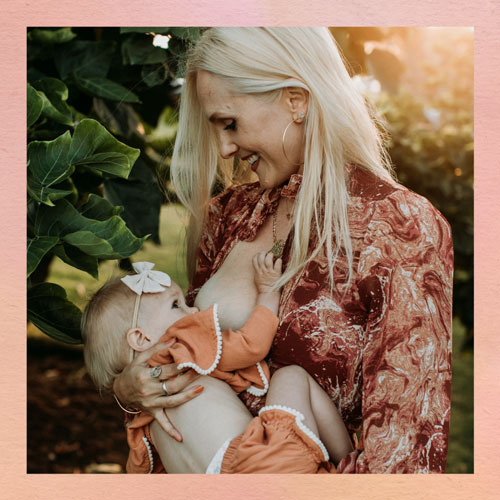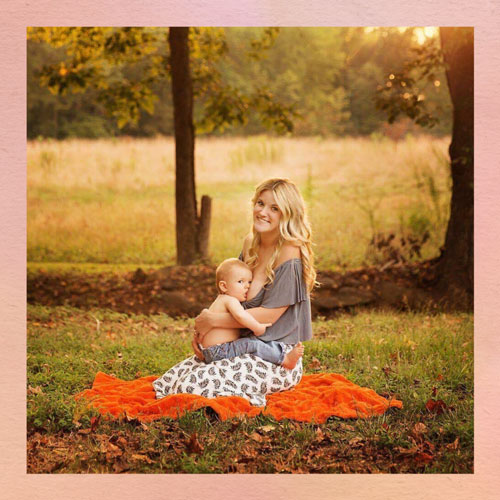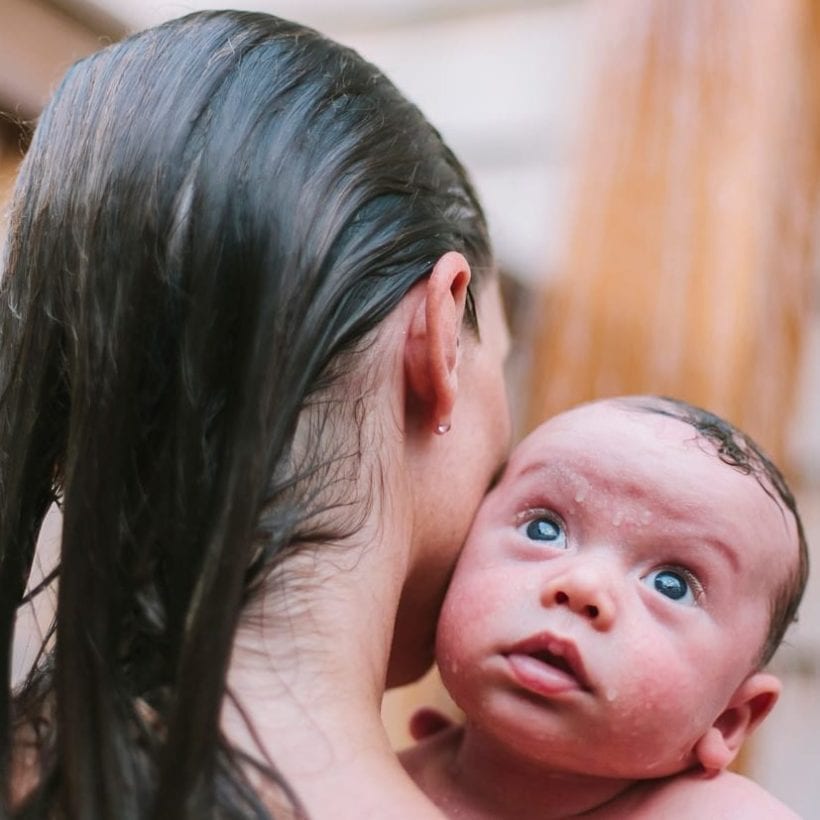Like many mothers, I spent my pregnancy dreaming of my baby. When would she arrive? What would she look like? How will we spend those sleep, early newborn days? Will I be a good mother? Nothing — and truly, I mean nothing — can prepare you for the rollercoaster that is the fourth trimester. Between hormones drops and sleepless nights, there’s so much to mentally, emotionally, and physically process — surviving each day is a victory.
I always imagined I would breastfeed. But, I didn’t realize how challenging this seemingly ‘natural’ process could be. When I look back on the first month of my daughter’s life, it nearly brings me to tears, remembering the frustration, the exhaustion, and the feelings of failure I harbored as her mom. Though we tried everything — including fixing her tongue and lip tie — she could never latch to my breast. And because she wasn’t extracting what she needed from me, her weight (and my supply) dropped.
After four weeks of trying everything, seeing lactation consultants, and pumping around the clock, I decided to switch to formula. It was heartbreaking for me, but one that ultimately gave me peace of mind and allowed me to connect with her rather than worrying about her ability to thrive.
During this experience, I learned how common breastfeeding challenges are and how helpful it is to connect with other moms. There’s comfort in having your tribe around you, making you realize that all of your anxieties about your child are normal, valid, and common.
In honor of World Breastfeeding Week, I talked with mothers about their journeys: the good, the bad, and everything in between. Remember, regardless if you’re able to breastfeed or not, if you choose to or not, you’re still the best parent for your baby, and you’re giving them all they need to grow up with health and happiness:
“Ask for help — and trust your gut.”

In the thick of the early days of the pandemic in July 2020, Jillian Thayer, the founder of Hunter Thayer Consulting, became a mama to her daughter, Rylan. At first, her breastfeeding journey was textbook, But, at three months old, Rylan was diagnosed with ‘failure to thrive.’ At that point, she stopped eating, refusing both the bottle and the boob, arching her back, spitting up, and crying inconsolably. The only way Thayer could feed her baby was to carefully feed her while she was sleeping since she refused to when she was awake. She continued to pump every three hours and fed her child with a syringe and supplement nursing system tube for four weeks.
Between the age of three months to one year, Thayer says they saw three different IBCLCs, three chiropractors, two pediatric dentists, three different pediatricians, an occupational therapist, various naturopaths, and gastroenterologists, a NAET specialist, acupuncturists, allergists, and more.
“Her first year was spent in pure survival mode, and now I finally feel like we can enjoy each other and the parenting journey.”
“After correcting an undiagnosed — and very hidden — tongue tie when she was four months old, she still refused to eat, but her latch was worlds better when she chose to,” Thayer continues. “For her to eat and breastfeed willingly, I began an elimination diet in December 2020, which lasted one full year, almost to the date.”
This wasn’t just cutting out dairy or soy — most days were spent eating five foods: grass-fed beef, blueberry, zucchini, sweet potato and plantain, and specific coconut water. “This very extreme diet lasted so long because she was so sensitive to everything I had — even if I had a grape or green bean. “Formula and a bottle wasn’t an option for us because she refused a bottle, and she was beyond allergic and would have a reaction to every ingredient in formula.”
Now at two years old, they no longer have the idea of a feeding tube looming over their heads. And while their diet is modified, it’s not as restricted. “It took a lot of blood (literal blood tests), sweat, and tears (lots of crying in the shower) to get to where we are today, but it was worth every second to see her thriving now. Her first year was spent in pure survival mode, and now I finally feel like we can enjoy each other and the parenting journey,” she says.
Throughout all this, Thayer learned that it’s necessary to explore every single option as a parent and trust your gut. “In my case, my gut was telling me otherwise at various doctor and specialist visits, especially when they told me she may need a feeding tube. I knew there was another way,” she says. “I listened to my instinct, and it’s gotten us to where we are today — feeding tube-free and a thriving, incredibly smart, and witty two-year-old.”
“People don’t realize how much breastfeeding takes out of you.”
=
Reva Minkoff, the founder, and president of Digital4Startups, Inc., became a mom in December of 2021. Breastfeeding her son came easy for Minkoff — and she’s been fortunate to avoid bleeding nipples, supply problems, and latching issues. For her, bonding and cuddle time while feeding makes her amazed by how much he’s grown solely off her breast milk.
“While it has been tough, I feel lucky to have been able to experience breastfeeding my son.”
But even if the process has been easier than many women face, Minkoff says people don’t realize how much breastfeeding takes out of a mom — not just literally and physically, but from a time perspective. She spent six hours a day breastfeeding when he was born, and now at six months, she still dedicates one and a half hours to feed him. It’s also an emotional experience and one that can be limiting and expensive.
“I needed a new wardrobe for the summer because my pre-pregnancy clothes — and pregnancy clothes — were incompatible with pumping or nursing, and I skipped a work conference because there was no time to pump in the schedule,” she says. “Nonetheless, while it has been tough, I feel lucky to have been able to experience breastfeeding my son.”
“Breastfeeding can look different than nursing.”

Christa Lee, The Sunday Edit’s Editorial Director, has a toddler with another girl on the way. After a traumatizing experience with a delay in milk production, which resulted in a dramatic weight loss for her baby during her first week of life, she finally found some success with breastfeeding. “By the time my milk came in, however, my nipples were cracked and bleeding — making the nursing experience entirely unenjoyable.
“I felt it was a cruel joke that my milk had finally come in, and I couldn’t tolerate breastfeeding.”
I felt it was a cruel joke that my milk had finally come in, and I couldn’t tolerate breastfeeding. I also had to pump to empty after nursing because my baby would fall asleep at the breast after a couple of minutes,” she says. Between nursing and pumping, the entire process of every feed took over an hour, not including the time it took to clean pump and bottle parts. “There was no such thing as sleeping when the baby slept,” she says.
After about a month of nursing and pumping, she decided that exclusive pumping would offer her more flexibility and time back from her day. “Many people asked that rather invasive question of ‘Are you breastfeeding?’ and I always felt like I needed to give a lengthy explanation that pumping five times a day for a year and giving her bottles was still considered breastfeeding. Now, with my second little girl on the way, if someone asks me that question and I’m choosing to exclusively pump again, the answer is a simple ‘yes.'”
“Celebrate the small wins.”

Jaime Maser Berman, the founder of Maser Communications, is the proud mama to four boys. She calls herself one of the lucky ones since she’s an overproducer when it comes to milk and all of her children latched easily. As a result, she only had a handful of breastfeeding woes (clogged ducts, chafed nipples, and engorgement), and she tolerated pumping. While she didn’t have too many hiccups herself, she knows from friends how challenging breastfeeding can be for women, which is why she says it’s so important to celebrate small wins.
“I was soaking up that connection between us — and thinking how wild it is what the bodies can do: create another life, sustain that other life in utero, and on Earthside.”
“Your baby latched for three minutes. You were able to transition off the nipple shield. You were able to nurse both sides before the baby fell asleep. Celebrate those wins. You deserve it,” she says. But also, don’t try to do it all on your own. Whether through lactation consultants and doulas, your partner, family members, or anyone, moms can’t (and shouldn’t have to) do it alone.
For her, those quiet moments with her children breastfeeding not only provided emotional and physical release and relief, but it was part of how she connected with her babies. This photo, particularly, is a special one, nursing her third son. They weren’t sure if they would have a fourth (they did!), so she truly savored the time. “He and I had such an easy rhythm with our feeds by then, and I was soaking up that connection between us — and thinking how wild it is what the bodies can do: create another life, sustain that other life in utero, and on Earthside.”
“Be easy on yourself.”

Lauren Rae Levy Vigneron, entrepreneur and celebrity stylist, became a mom in December 2020 and has been breastfeeding for 19 months. She’s now in the process of weaning and says it’s been a magical journey. At first, it was a struggle because she breastfed exclusively, and it was an exhausting experience. In addition, because her son depended on her to eat, she didn’t get the break that all parents needed. That’s why her best advice to moms is to be kind to themselves and remember that “fed is best.”
“I am sitting in postpartum C-section recovery undies with nothing else… We did as much skin-to-skin as we could.”
And while the breastfeeding process does get easier with time, it also changes as the months pass. “Once you introduce solids, you don’t have to feed as often, and once you hit the one-year mark, if you choose to continue, you may use whole milk for some feeds,” she reminds.
This photo is Vigneron’s favorite since it was the first picture taken of her that wasn’t a selfie. And it’s about as real as it gets: “I had Carpal tunnel toward the end of my pregnancy and for the first month postpartum, so I had to wear wrist braces constantly. I am sitting in postpartum C-section recovery undies with nothing else cause that’s how I honestly was almost all day for the first two weeks I was home. Kingston is only in a diaper cause we did as much skin-to-skin as we could, and it was nothing shy of magical,” she shares.
“Don’t give up if it’s important to you.”

The founder of Love Publicity, Teia Wallington, became a mom in 2020, but she sadly suffered a second-trimester loss. In January 2022, she welcomed her rainbow baby, a son. Once he made his grand entrance, Wallington was so sick from anesthesia the first 24 hours following birth that she couldn’t keep down food or muster the energy to feed her baby. At the hospital, she was told to supplement with formula. Once she felt better, she had to play catch-up to encourage her supply, and the hospital lactation nurse gave her advice and guidance.
However, once she returned home, her baby struggled with latching, so she supplemented again so he would continue to thrive. Unfortunately, her formula was part of the recall, and her one-month-old son ended up in the emergency room. That day, Wallington became determined to breastfeed exclusively. The next day, she hired a lactation specialist who made three home visits. They also booked an appointment with a pediatric dentist who said he didn’t have a tongue tie, but her son has to hold tension in his left neck. They then had a session with a craniosacral therapist and a pediatric chiropractor.
At his four-month visit, Wallington told the pediatrician the lengths they were going through, and she prescribed physical therapy. Finally, they had an answer: her son was suffering from torticollis, causing tension in his neck. After a few sessions and eventually a helmet to correct his torticollis, he’s been latching like a pro.
Now, her son exclusively drinks breast milk, making this photo incredibly special. “This photo marked a turning point,” she shares. “I used to be so stressed trying to ensure my son was latching and getting enough milk; I couldn’t focus on anything else. Now I can pop him on the boob and work on client stuff.”
“Put the health and well-being of you and your baby first.”

For mom of two, Sara Martin, both breastfeeding journeys began with a hospital-grade breast pump because her children arrived early and spent time in the NICU. After varying degrees of transition — NG tubes, tiny bottles with ratios of formula and breastmilk, nipple shields — Martin was able to successfully nurse her first for nine months and the second for 14 months.
“Experiencing motherhood together, especially during a global pandemic with my youngest, made me extra appreciative of my bond with my sisters.”
Her advice for new moms is to accept all the help (other parents, lactation consultants, and so on) while balancing the early postpartum breastfeeding days with your mama intuition. “Do what feels right, be flexible, and put the health and well-being of you and your babies first,” she urges.
Martin’s favorite photo is also one of her only breastfeeding photos. “This photo is of me in the center and my sisters breastfeeding our babes while sitting in my yard in August 2020,” she shares. “Experiencing motherhood together, especially during a global pandemic with my youngest, made me extra appreciative of my bond with my sisters. They are my confidants, role models, and best friends.”
“Your baby will thrive with breastmilk or formula.”

Sunday Edit contributor, writer, editor, and content strategist Jenn Sinrich welcomed her daughter to the world in April 2019. Breastfeeding was always something she wanted to do — but as a journalist, she also knew the struggles that often come with it. While she was able to breastfeed her daughter for 13 months, she was glad she decided to start supplementing with formula around the six-month mark. Her baby received 90% breastmilk and 10% formula — that 10% was a ‘sanity saver.’
“Breastfeeding places all of the feeding demands on the mother, which can be incredibly daunting, especially if you’re a working mom like me.”
“Breastfeeding places all of the feeding demands on the mother, which can be incredibly daunting, especially if you’re a working mom like me,” she shares. “My advice to new moms is always to do what feels right for you. Breastfeeding will only be a serendipitous experience if you’re happy and content with it. Your baby will thrive whether or not they are fed breastmilk or formula. Adjusting your feeding protocol to fit your mental, physical, and emotional needs is the key.”
Sinrich felt so proud to be nursing her child — especially in public — because she believes it’s important that women feel comfortable doing so. “Though I am wearing a cover-up, it is for me and no one else. I think it’s beautiful and important that women nurse publically with however much or little covering up they feel they want — because they certainly don’t need it,” she adds.
“Use all of the resources you can find.”

Beth Booker, the CEO and founder of Gracie PR & Marketing and CEO and co-founder of Penny Lane PR, is a mom of two boys. So she approached breastfeeding like any other unfamiliar task by diving in and learning as much as possible. She started by taking a breastfeeding class so she knew what to expect and what she needed to have on hand to prepare. These included nursing pillows, bras and pads, medical-grade breast pump, foods, and supplements to increase supplies, nipple creams, and so on.
Her class was at a local hospital, and she brought her partner along, too. “I learned different ways to hold your baby while nursing, what to do if you have a clogged milk duct, how to hold your breast and get your baby to latch, and so many more valuable tips that helped me feel prepared,” she shares. “Luckily, it’s like riding a bicycle, and by the time I had my second baby, I remembered all the basics and knew what to expect.”
“This group of strangers helped me and gave me advice until I could chat with my midwife.”
Also, Booker reminds new moms that no two mothers have the same breastfeeding experience; however, first-hand advice and support can be extremely beneficial. “I never had clogged ducts or mastitis with my first baby, but I did with my second. So I reached out to a local mom group on social media to ask for advice on what to do, and this group of strangers helped me and gave me advice until I could chat with my midwife,” she shares.
This breastfeeding photo with her firstborn, right after his first birthday, is a moment of pride for Booker. She was proud of herself for nursing for an entire year and wanted to celebrate how incredible moms are. “I graduated with my master’s degree when my firstborn was eight months old and navigated the loss of my dad when he was nine months old, and through every challenge thrown my way, we made it to 20 months total,” she shares. “Additionally, when his brother was born in 2018, I nursed him for 20 months. With both of my babies, I nursed them for 40 months, which I will always be proud of.”
We only recommend products we have independently researched, tested, and loved. If you purchase a product found through our links, Sunday Edit may earn an affiliate commission.







